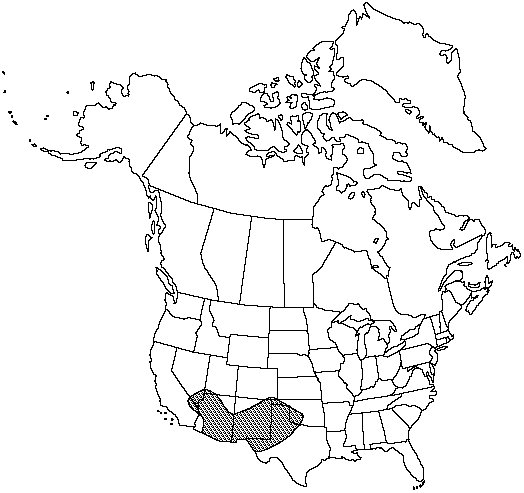Cheilanthes wootonii
Proc. Biol. Soc. Wash. 3: 146. 1918.
Stems long-creeping, 1–3 mm diam.; scales uniformly brown or weakly bicolored with poorly defined, dark, central stripe, lanceolate-ovate, straight to slightly contorted, loosely appressed, often deciduous on older portions of stem. Leaves scattered, 7–35 cm; vernation noncircinate. Petiole usually dark-brown, rounded adaxially. Blade oblong-lanceolate, 3–4-pinnate at base, 2–5 cm wide; rachis rounded adaxially, with scattered linear-lanceolate scales and sparse monomorphic pubescence. Pinnae not articulate, dark color of stalk continuing into pinna base, basal pair not conspicuously larger than adjacent pair, usually equilateral, appearing glabrous adaxially. Costae green adaxially for most of length; abaxial scales multiseriate, lanceolate-ovate, truncate or subcordate at base, without overlapping basal lobes, conspicuous, the largest 0.4–0.8 mm wide, strongly imbricate, often concealing ultimate segments, ciliate, with coarse cilia often confined to proximal 1/2. Ultimate segments round to oblong, beadlike, the largest 1–3 mm, abaxially glabrous or with a few small scales near base, adaxially glabrous. False indusia marginal, weakly differentiated, 0.05–0.25 mm wide. Sori ± continuous around segment margins. Sporangia containing 32 spores. n = 2n = 90, apogamous.
Phenology: Sporulating summer–fall.
Habitat: Rocky slopes and ledges, usually on igneous substrates
Elevation: 800–2900 m
Distribution

Ariz., Calif., Colo., Nev., N.Mex., Okla., Tex., Utah, n Mexico
Discussion
Like its close relative Cheilanthes lindheimeri, C. wootonii is an apogamous triploid of unknown parentage. With the recognition of C. yavapensis as a distinct species, the name C. wootonii is restricted to populations with leaf blades that appear glabrous adaxially, costal scales that are often ciliate only in the proximal half, and stem scales that are usually brown and loosely appressed. In addition, C. wootonii is distinguished from C. yavapensis by having smaller spores, averaging less than 62 µm in diameter. These characteristics can be subtle, and some specimens will be difficult to place in either C. wootonii or C. yavapensis. T. Reeves (1979) identified several specimens from Arizona that he hypothesized were hybrids between C. wootonii and C. fendleri.
Selected References
None.